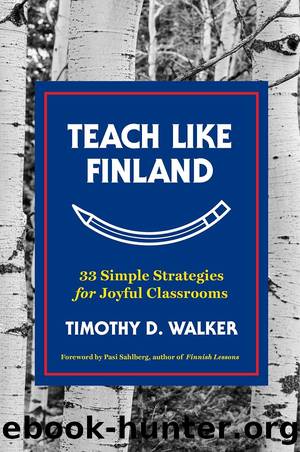Teach Like Finland: 33 Simple Strategies for Joyful Classrooms by Timothy D. Walker

Author:Timothy D. Walker [Walker, Timothy D.]
Language: eng
Format: epub
ISBN: 9781324001256
Google: t72nDgAAQBAJ
Amazon: 1324001259
Published: 2017-04-18T00:00:00+00:00
Offer choices
While the experiment of Independent Learning Week was successful (in the sense that all of my students completed their work), it had one major flaw: my Helsinki fifth graders lacked choices. I could argue that my students had lots of freedom during Independent Learning Week because they could choose when to complete any given assignment during those fifteen classroom hours. But I donât think that argument would have satisfied many of my fifth graders.
Sitting in a circle on the floor, after completing Independent Learning Week, I heard their feedback loud and clear. Many of my students felt that too much work was assigned, especially in math. Not only that, but some of them also complained that the weekâs tasks felt irrelevant and boring.
Their feedback was valuable, but I admit that it wasnât nice to hear. I wanted to focus on the positive side (everyone eventually finished the mountain of work!). But what seemed most important to dwell onâto many of my Helsinki fifth graders, at leastâwas the major flaw they perceived in the Independent Learning Week: a lack of good choices.
I found myself agreeing with their critique. By assigning everyone the same boatload of tasks, Independent Learning Week had failed to account for their individual learning strengths and interests. For that reason, my students werenât offered good choices. They were simply following my orders, aligned with the curriculum.
After that experience, I felt reluctant to try Independent Learning Week again. I knew it wasnât a catastropheâmy students had worked autonomously and found successâbut I sensed that doing it again (and doing it better) would require a significant shift. If I was going to offer them good choices, Iâd need to do a better job of connecting their interests to the curriculum (something I discuss later). In hindsight, most assignments of the Independent Learning Week were rigid and intentionally manageable for both teachers and students, like the task of completing math problems from a workbook. There was little room for students to exercise choice while working.
During my meeting with a small group of Finnish kindergarten educators at Niirala Preschool in Kuopio, Finland, they suggested that their primary job, as teachers, is to make the connection between student interests and the curriculum. They explained that, in order to facilitate this convergence, they need to identify the interests of their students first, so observing children and discussing their interests is always a priority in their classrooms. One of these Finnish educators remarked that if a child showed interest in Angry Birds, a teacher could leverage this fascination in the classroom. Initially, it seemed like a stretch of the imagination, but I decided to bite my tongue. At the end of the meeting I asked her about this idea of connecting a childâs interest in Angry Birds to the curriculum. I wanted concrete examples. Gleefully, these three kindergarten educators suggested different possibilities: categorizing, counting, naming, story building, role-playing . . . they could have continued to rattle off different curriculum-related exercises, but I playfully
Download
This site does not store any files on its server. We only index and link to content provided by other sites. Please contact the content providers to delete copyright contents if any and email us, we'll remove relevant links or contents immediately.
The Art of Coaching Workbook by Elena Aguilar(48044)
Trainspotting by Irvine Welsh(20046)
Twilight of the Idols With the Antichrist and Ecce Homo by Friedrich Nietzsche(17703)
Fangirl by Rainbow Rowell(7828)
Periodization Training for Sports by Tudor Bompa(7324)
Change Your Questions, Change Your Life by Marilee Adams(6637)
This Is How You Lose Her by Junot Diaz(5754)
Grit by Angela Duckworth(4729)
Red Sparrow by Jason Matthews(4655)
Asking the Right Questions: A Guide to Critical Thinking by M. Neil Browne & Stuart M. Keeley(4567)
Paper Towns by Green John(4165)
Room 212 by Kate Stewart(4099)
Ken Follett - World without end by Ken Follett(3968)
The Sports Rules Book by Human Kinetics(3582)
Housekeeping by Marilynne Robinson(3397)
The Motorcycle Diaries by Ernesto Che Guevara(3326)
Introduction to Kinesiology by Shirl J. Hoffman(3297)
Exercise Technique Manual for Resistance Training by National Strength & Conditioning Association(3288)
Double Down (Diary of a Wimpy Kid Book 11) by Jeff Kinney(3267)
